Alternative Furrow Irrigation Combined with Topdressing Nitrogen at Jointing Help Yield Formation and Water Use of Winter Wheat under No-Till Ridge Furrow Planting System in Semi-Humid Drought-Prone Areas of China
Abstract
1. Introduction
2. Materials and Methods
2.1. Study Site Description
2.2. Experimental Design and Field Management
2.3. Measurements and Methods
2.3.1. Soil Water
2.3.2. Leaf SPAD and Net Photosynthesis Rate (Pn)
2.3.3. Aboveground Dry Matter Accumulation
2.3.4. Grain Yield, Yield Components and Harvest Index (HI)
2.3.5. Water Use Efficiency
2.3.6. Economic Benefit
2.3.7. Contributions of Different Factors to the Grain Yield and WUE
2.4. Statistical Analysis
3. Results
3.1. Soil Water
3.2. Leaf SPAD and Pn
3.3. Aboveground Dry Matter Accumulation and Translocation
3.4. Grain Yield, Yield Components and Harvest Index
3.5. Water Consumption (WC) and Water Use Efficiency (WUE)
3.6. Economic Benefits
3.7. Contributions of Different Factors (FI, Cfi; AFI, Cafi; TN, Ctn; and Interaction between AFI and TN, Cat) to the Winter Wheat Grain Yield and WUE
4. Discussion
4.1. Alternative Furrow Irrigation Combined with Topdressing Nitrogen at Jointing Optimized Soil Water
4.2. Alternative Furrow Irrigation Combined with Topdressing Nitrogen at Jointing Increased Leaf SPAD and Pn and Improved Aboveground Dry Matter Accumulation
4.3. Alternative Furrow Irrigation Combined with Topdressing Nitrogen at Jointing Increased Grain Yield, WUE and Economic Benefit
5. Conclusions
Author Contributions
Funding
Data Availability Statement
Acknowledgments
Conflicts of Interest
References
- FAO. 2021. Available online: https://www.fao.org/faostat/en/#data/QC (accessed on 24 March 2023).
- Zhang, X.; Li, X.H.; Luo, L.C.; Ma, Q.X.; Ma, Q.; Hui, X.L.; Wang, S.; Liu, J.S.; Wang, Z.H. Monitoring wheat nitrogen requirement and top soil nitrate for nitrate residue controlling in drylands. J. Clean. Prod. 2019, 241, 118372. [Google Scholar] [CrossRef]
- Sun, M.; Ren, A.X.; Gao, Z.Q.; Wang, P.; Mo, F.; Xue, L.Z.; Lei, M.M. Long–term evaluation of tillage methods in fallow season for soil water storage, wheat yield and water use efficiency in semiarid southeast of the Loess Plateau. Field Crops Res. 2018, 218, 24–32. [Google Scholar] [CrossRef]
- Zhang, X.D.; Kamran, M.; Li, F.J.; Xue, X.K.; Jia, Z.K.; Han, Q.F. Optimizing fertilization under ridge–furrow rainfall harvesting system to improve foxtail millet yield and water use in a semiarid region, China. Agric. Water Manag. 2020, 227, 105852. [Google Scholar] [CrossRef]
- Du, T.S.; Kang, S.Z.; Sun, J.S.; Zhang, X.Y.; Zhang, J.H. An improved water use efficiency of cereals under temporal and spatial deficit irrigation in North China. Agric. Water Manag. 2010, 97, 66–74. [Google Scholar] [CrossRef]
- Huang, M.; Wang, Z.H.; Luo, L.C.; Wang, S.; Hui, X.L.; He, G.; Cao, H.B.; Ma, X.L.; Huang, T.M.; Zhao, Y.; et al. Soil testing at harvest to enhance productivity and reduce nitrate residues in dryland wheat production. Field Crops Res. 2017, 212, 153–164. [Google Scholar] [CrossRef]
- Liang, W.X.; Blennow, A.; Herburger, K.; Zhong, Y.Y.; Wen, X.X.; Liu, Y.; Liao, Y.C. Effects of supplemental irrigation on winter wheat starch structure and properties under ridge–furrow tillage and flat tillage. Carbohydr. Polym. 2021, 270, 118310. [Google Scholar] [CrossRef]
- Gan, Y.; Siddique, K.H.M.; Turner, N.C.; Li, X.G.; Niu, J.Y.; Yang, C.; Liu, L.P.; Chai, Q. Ridge–furrow mulching systems–an innovative technique for boosting crop productivity in semiarid rain–fed environments. Adv. Agron. 2013, 125, 429–476. [Google Scholar]
- Li, W.W.; Xiong, L.; Wang, C.J.; Liao, Y.C.; Wu, W. Optimized ridge–furrow with plastic film mulching system to use precipitation efficiently for winter wheat production in dry semi–humid areas. Agric. Water Manag. 2019, 218, 211–221. [Google Scholar] [CrossRef]
- Kang, S.Z.; Zhang, J.H. Controlled alternate partial root–zone irrigation: Its physiological consequences and impact on water use efficiency. J. Exp. Bot. 2004, 55, 2437–2446. [Google Scholar] [CrossRef]
- Ali, S.; Xu, Y.Y.; Jia, Q.M.; Ahmad, I.; Wei, T.; Ren, X.L.; Zhang, P.; Din, R.X.; Cai, T.; Jia, Z.K. Cultivation techniques combined with deficit irrigation improves winter wheat photosynthetic characteristics, dry matter translocation and water use efficiency under simulated rainfall conditions. Agric. Water Manag. 2018, 201, 207–218. [Google Scholar] [CrossRef]
- Zhao, K.N.; Wang, H.T.; Wu, J.Z.; Liu, A.K.; Huang, X.L.; Li, G.Q.; Wu, S.W.; Zhang, J.; Zhang, Z.W.; Hou, Y.Q.; et al. One–off irrigation improves water and nitrogen use efficiency and productivity of wheat as mediated by nitrogen rate and tillage in drought–prone areas. Field Crops Res. 2023, 295, 108898. [Google Scholar] [CrossRef]
- Luo, J.; Liang, Z.M.; Xi, L.Y.; Liao, Y.C.; Liu, Y. Plastic–covered ridge–furrow planting combined with supplemental irrigation based on measuring soil moisture promotes wheat grain yield and irrigation water use efficiency in irrigated fields on the Loess Plateau, China. Agron. J. 2020, 10, 1010. [Google Scholar] [CrossRef]
- Xiao, Y.; Zhang, J.; Jia, T.T.; Pang, X.P.; Guo, Z.G. Effects of alternate furrow irrigation on the biomass and quality of alfalfa (Medicago sativa). Agric. Water Manag. 2015, 161, 147–154. [Google Scholar] [CrossRef]
- Adel, M.; Sina, B.; Fariborz, A. Effects of irrigation and fertilization management on reducing nitrogen losses and increasing corn yield under furrow irrigation. Agric. Water Manag. 2019, 213, 1116–1129. [Google Scholar]
- Dong, F.; Yan, Q.Y.; Yang, F.; Zhang, J.C.; Wang, J.L. Yield structure and water use efficiency of summer maize (Zea mays L.) under wide ridge–furrow planting in the furrow irrigation process. Arch. Agron. Soil Sci. 2021, 69, 15. [Google Scholar] [CrossRef]
- Li, X.H.; Sheng, K.; Wang, Y.H.; Dong, Y.Q.; Jiang, J.K.; Sun, J.S. Influence of furrow irrigation regime on the yield and water consumption indicators of winter wheat based on a multi–level fuzzy comprehensive evaluation. Open Life Sci. 2022, 17, 1094–1103. [Google Scholar] [CrossRef]
- Li, Z.Z.; Zhang, W.H.; Sun, Z.H. Yield and water use efficiency of non–and single–irrigated alfalfa with ridge and furrow planting in northern China. Agron J. 2015, 107, 1039–1047. [Google Scholar] [CrossRef]
- Gelu, G. Alternative furrow irrigation effect on onion (Allium cepa L.) yield. Commun. Soil Sci. Plant Anal. 2023, 54, 864–872. [Google Scholar] [CrossRef]
- Horst, M.G.; Shamutalov, S.S.; Gonçalves, J.M.; Pereira, L.S. Assessing impacts of surge–flow irrigation on water saving and productivity of cotton. Agric. Water Manag. 2007, 87, 115–127. [Google Scholar] [CrossRef]
- Jia, D.Y.; Dai, X.L.; Xie, Y.Y.; He, M.R. Alternate furrow irrigation improves grain yield and nitrogen use efficiency in winter wheat. Agric. Water Manag. 2021, 244, 106606. [Google Scholar] [CrossRef]
- Ali, S.; Xu, Y.Y.; Ma, X.C.; Jia, Q.M.; Jia, Z.K. Farming methods and deficit irrigation management improve winter wheat crop water productivity and biomass through mitigated greenhouse gas intensity under semi–arid regions. Environ. Sci. Pollut. Res. 2021, 28, 27666–27680. [Google Scholar] [CrossRef] [PubMed]
- Leininger, S.D.; Krutz, L.J.; Sarver, J.M.; Gore, J.; Henn, A.; Bryant, C.J.; Atwill, R.L.; Spencer, G.D. Skip row, furrow irrigation optimizes peanut pod yield, net returns, and irrigation water use efficiency. Crop Forage Turf. Man. 2019, 5, 1–6. [Google Scholar] [CrossRef]
- Zhao, H.B.; Wang, Z.H.; Xue, C.; Huang, D.L.; Malhi, S.S. Increased dryland winter wheat yields by nitrogen fertilizer topdressing and its relationship to soil moisture, available N, P and K in northwestern China. Commun. Soil Sci. Plant Anal. 2016, 47, 543–553. [Google Scholar] [CrossRef]
- Ji, J.C.; Liu, J.L.; Chen, J.J.; Niu, Y.J.; Xuan, K.F.; Jiang, Y.F.; Jia, R.H.; Wang, C.; Li, X.P. Optimization of topdressing for winter wheat by accurate growth monitoring and improved production estimation. Remote Sens. 2021, 13, 2349. [Google Scholar] [CrossRef]
- Ren, X.L.; Jia, Z.K.; Chen, X.L. Rainfall concentration for increasing corn production under semiarid climate. Agric. Water Manag. 2008, 95, 1293–1302. [Google Scholar] [CrossRef]
- Jiang, X.J.; Liu, W.J.; Wang, E.H.; Zhou, T.Z.; Xin, P. Residual plastic film mulch fragments effects on soil physical properties and water flow behavior in the Minqin Oasis, northwestern China. Soil Tillage Res. 2017, 166, 100–107. [Google Scholar] [CrossRef]
- Jin, T.; Tang, J.; Lyu, H.; Wang, L.; Gillmore, A.B.; Schaeffer, S.M. Activities of microplastics (MPs) in agricultural soil: A review of MPs pollution from the agric ecosyst environ. J. Agric. Food Chem. 2022, 70, 4182–4201. [Google Scholar] [CrossRef]
- Yang, Z.S.; Wu, J.Z.; Huang, M.; Li, Y.J.; Fu, G.Z.; Zhao, K.N.; Zhang, Z.W.; Hou, Y.Q. Effects of furrow planting and fertilization optimization on wheat yield, water and fertilizer use efficiency in dryland. Acta Agric. Boreali—Sin. 2021, 36, 157–166. (In Chinese) [Google Scholar]
- Zhao, J.; Lin, W.; Sun, M.; Ren, A.X.; Tong, J.; Li, H.; Wang, X.W.; Gao, Z.Q. Effects of deep ploughing during the fallow period and soil moisture–based furrow sowing on water and nitrogen utilization of dryland wheat. Ying Yong Sheng Tai Xue Bao 2021, 32, 1307–1316. (In Chinese) [Google Scholar]
- Bao, S.D. Soil Agrochemical Analysis, 3rd ed.; China Agriculture Press: Beijing, China, 2000; pp. 25–114. (In Chinese) [Google Scholar]
- Liu, Y.; Zhang, X.L.; Xi, L.Y.; Liao, Y.C.; Han, J. Ridge–furrow planting promotes wheat grain yield and water productivity in the irrigated semi–humid region of China. Agric. Water Manag. 2020, 231, 105935. [Google Scholar] [CrossRef]
- Ebrahimian, H. Soil infiltration characteristics in alternate and conventional furrow irrigation using different estimation methods. KSCE J. Civ. Eng. 2014, 18, 1904–1911. [Google Scholar] [CrossRef]
- Mehrabia, F.; Sepaskhah, A.R.; Ahmadi, S.H. Winter wheat root distribution with irrigation, planting methods, and nitrogen application. Nutr. Cycl. Agroecosyst. 2021, 119, 231–245. [Google Scholar] [CrossRef]
- Hu, Y.J.; Ma, P.H.; Wu, S.F.; Sun, B.H.; Feng, H.; Pan, X.L.; Zhang, B.L.; Chen, G.J.; Duan, C.X.; Lei, Q.; et al. Spatial–temporal distribution of winter wheat (Triticum aestivum L.) roots and water use efficiency under ridge–furrow dual mulching. Agric. Water Manag. 2020, 240, 106301. [Google Scholar] [CrossRef]
- Liu, W.X.; Ma, G.; Wang, C.Y.; Wang, J.R.; Lu, H.F.; Li, S.S.; Feng, W.; Xie, Y.X.; Ma, D.Y.; Kang, G.Z. Irrigation and nitrogen regimes promote the use of soil water and nitrate nitrogen from deep soil layers by regulating root growth in wheat. Front. Plant Sci. 2018, 9, 32. [Google Scholar] [CrossRef] [PubMed]
- Anapalli, S.S.; Pinnamaneni, S.R.; Reddy, K.N.; Singh, G. Eddy covariance quantification of corn water use and yield responses to irrigations on farm–scale fields. Agron J. 2022, 114, 2445–2457. [Google Scholar] [CrossRef]
- Ali, S.; Ma, X.C.; Jia, Q.M.; Ahmad, I.; Ahmad, S.; Zhang, S.; Bai, Y.; Adil, M.; Ren, X.L.; Sha, S.H.; et al. Supplemental irrigation strategy for improving grain filling, economic return, and production in winter wheat under the ridge and furrow rainwater harvesting system. Agric Water Manag. 2019, 226, 105842. [Google Scholar] [CrossRef]
- Chen, X.; Hao, M.D. Low contribution of photosynthesis and water–use efficiency to improvement of grain yield in Chinese wheat. Potosynthetica 2015, 53, 519–526. [Google Scholar] [CrossRef]
- Ge, T.D.; Sui, F.G.; Bai, L.P.; Tong, C.L.; Sun, N.B. Effects of water stress on growth biomass partitioning, and water–use efficiency in summer maize (Zea mays L.) throughout the growth cycle. Acta Physiol. Plant. 2012, 34, 1043–1053. [Google Scholar] [CrossRef]
- Wu, Y.L.; Guo, Q.F.; Luo, Y.; Tian, F.X.; Wang, W.C. Differences in physiological characteristics between two wheat cultivars exposed to field water deficit conditions. Russ. J. Plant Physiol. 2014, 61, 451–459. [Google Scholar] [CrossRef]
- Kang, S.Z.; Liang, Z.S.; Pan, Y.H.; Shi, P.Z.; Zhang, J.H. Alternate furrow irrigation for maize production in an arid area. Agric. Water Manag. 2000, 45, 267–274. [Google Scholar] [CrossRef]
- Ercoli, L.; Lulli, L.; Mariotti, M.; Masoni, A.; Arduini, I. Post–anthesis dry matter and nitrogen dynamics in durum wheat as affected by nitrogen supply and soil water availability. Eur. J. Agron. 2008, 28, 138–147. [Google Scholar] [CrossRef]
- Fan, T.L.; Wang, S.Y.; Li, Y.P.; Yang, X.M.; Li, S.Z.; Ma, M.S. Film mulched furrow–ridge water harvesting planting improves agronomic productivity and water use efficiency in Rainfed Areas. Agric. Water Manag. 2019, 217, 1–10. [Google Scholar] [CrossRef]
- He, Z.H.; Zhuang, Q.S.; Cheng, S.H.; Yu, Z.W.; Zhao, Z.D.; Liu, X. Wheat production and technology improvement in China. J. Integr. Agric. 2018, 8, 99–106. [Google Scholar]
- Jia, D.Y.; Dai, X.L.; Men, H.W.; He, M. Assessment of winter wheat (Triticum aestivum L.) grown under alternate furrow irrigation in northern China: Grain yield and water use efficiency. Can. J. Plant Sci. 2014, 94, 349–359. [Google Scholar] [CrossRef]
- Mehrabia, F.; Sepaskhah, A.R. Partial root zone drying irrigation, planting methods and nitrogen fertilization influence on physiologic and agronomic parameters of winter wheat. Agric. Water Manag. 2019, 223, 105–668. [Google Scholar] [CrossRef]
- Wang, C.Y.; Liu, W.X.; Li, Q.X.; Ma, D.Y.; Lu, H.F.; Feng, W.; Xie, Y.X.; Zhu, Y.J.; Guo, T.C. Effects of different irrigation and nitrogen regimes on root growth and its correlation with aboveground plant parts in high–yielding wheat under field conditions. Field Crops Res. 2014, 165, 138–149. [Google Scholar] [CrossRef]
- Mo, F.; Wang, J.Y.; Xiong, Y.C.; Nguluu, S.N.; Li, F.M. Ridge–furrow mulching system in semiarid Kenya: A promising solution to improve soil water availability and maize productivity. Agron J. 2016, 80, 124–136. [Google Scholar] [CrossRef]
- Li, S.X.; Wang, Z.H.; Li, S.; Gao, Y.J. Effect of nitrogen fertilization under plastic mulched and non–plastic mulched conditions on water use by maize plants in dryland areas of China. Agric. Water Manag. 2015, 162, 15–32. [Google Scholar] [CrossRef]
- Barideh, R.; Besharat, S.; Morteza, M.; Rezaverdinejad, V. Effects of partial root zone irrigation on the water use efficiency and root water and nitrate uptake of corn. Water 2018, 10, 526. [Google Scholar] [CrossRef]
- Sarker, K.K.; Akanda, M.A.R.; Biswas, S.K.; Roy, D.K.; Khatun, A.; Goffar, M.A. Field performance of alternate wetting and drying furrow irrigation on tomato crop growth, yield, water use efficiency, quality and profitability. J. Integr. Agric. 2016, 15, 2380–2392. [Google Scholar] [CrossRef]
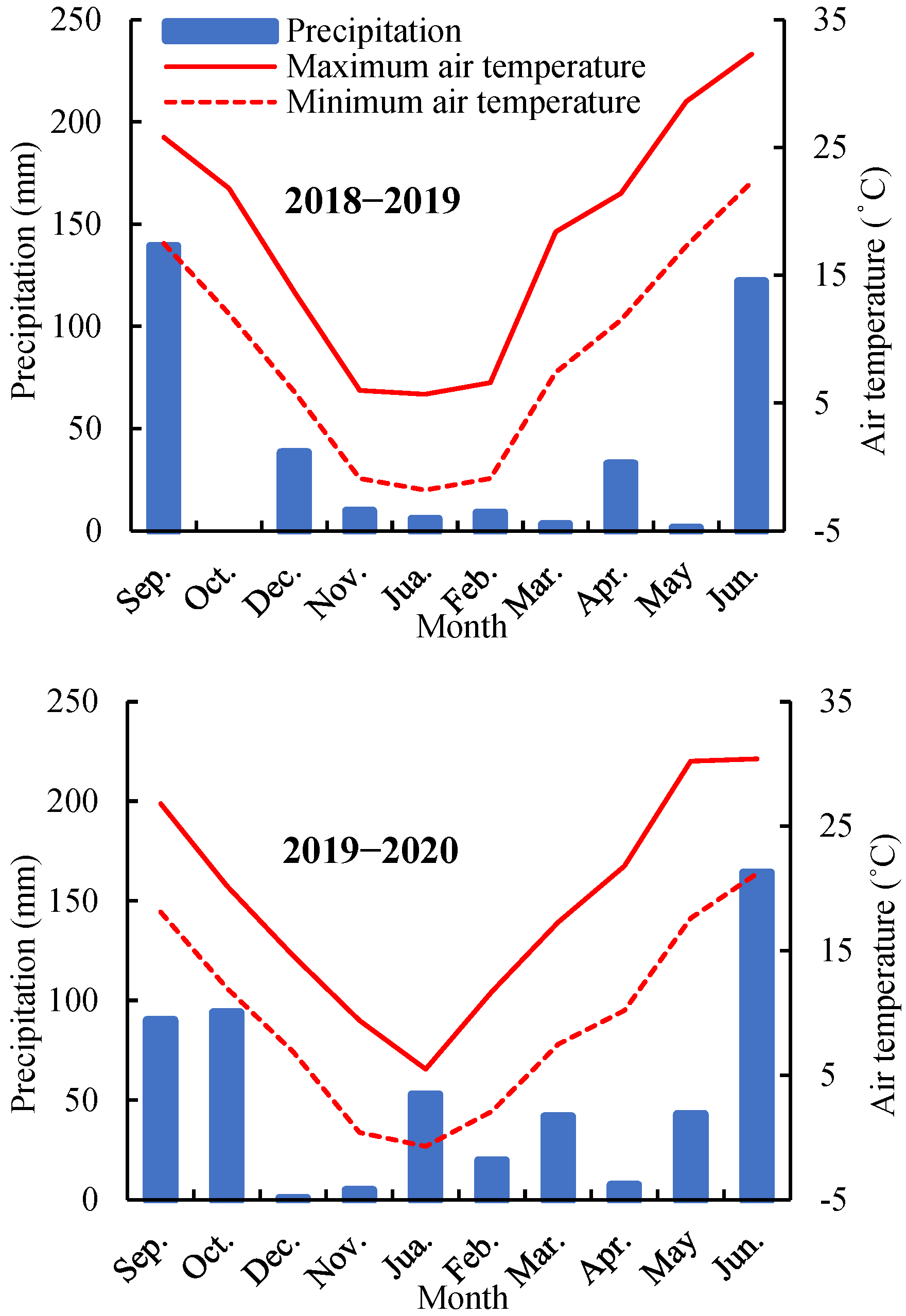
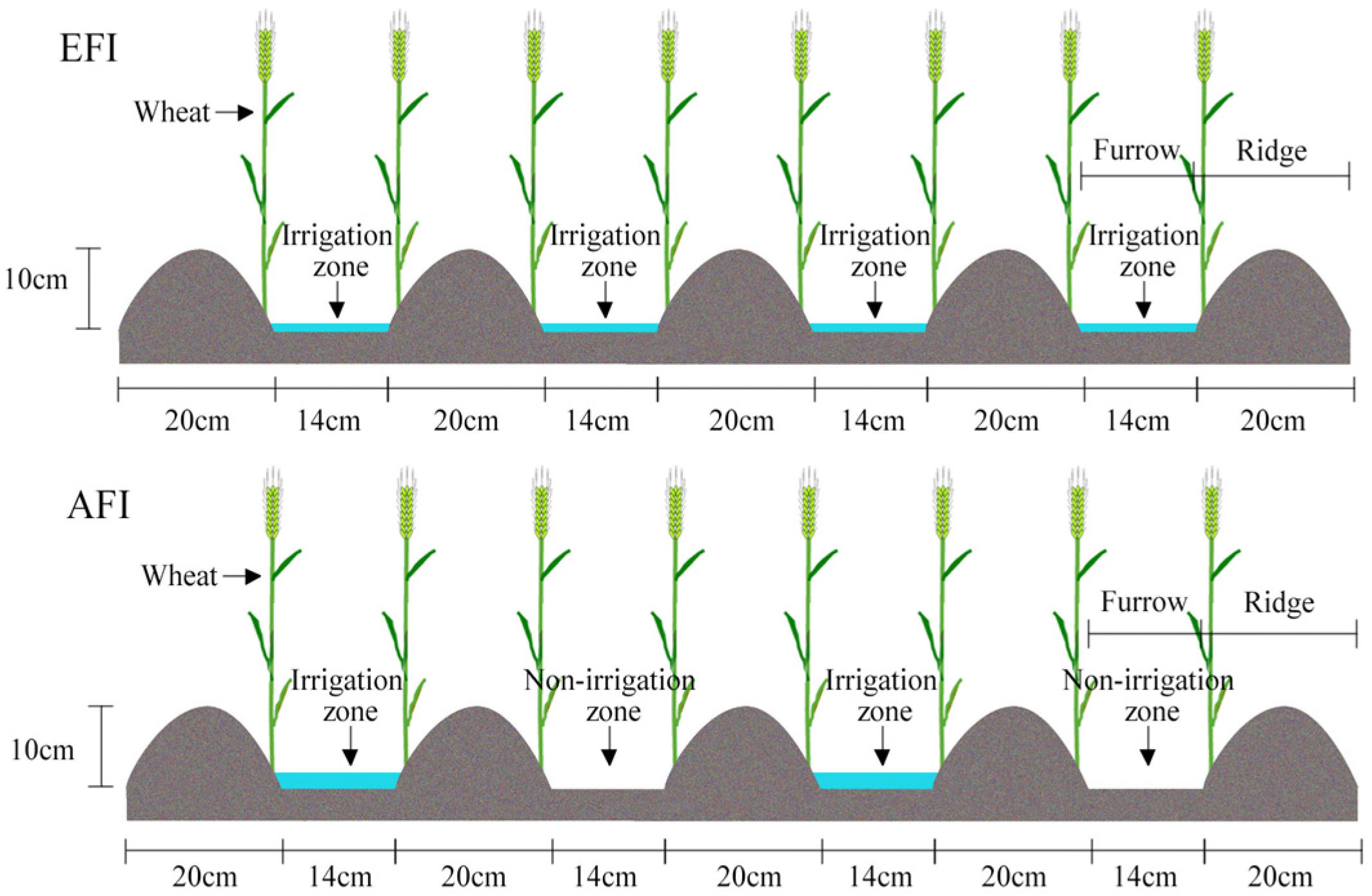
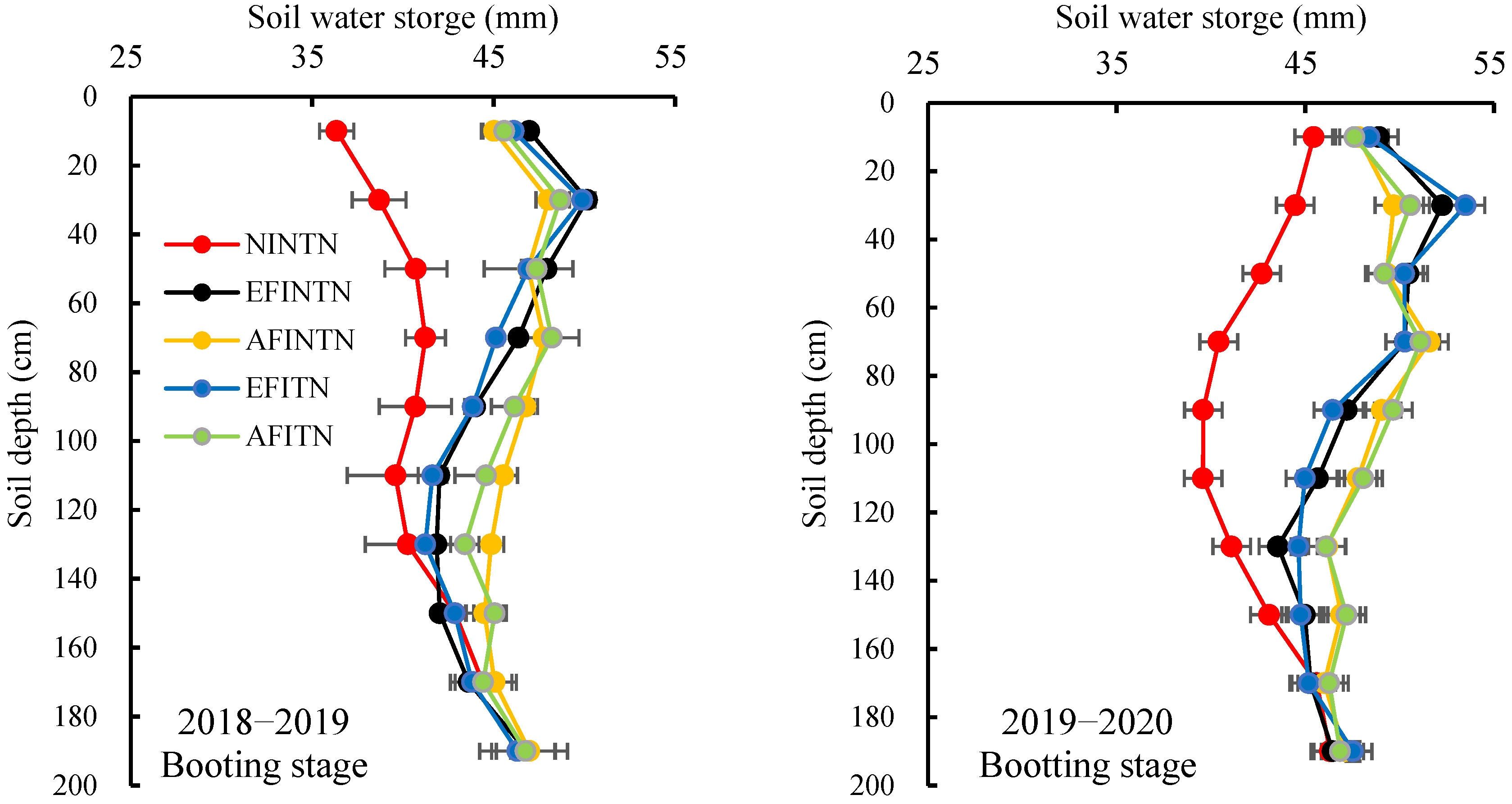
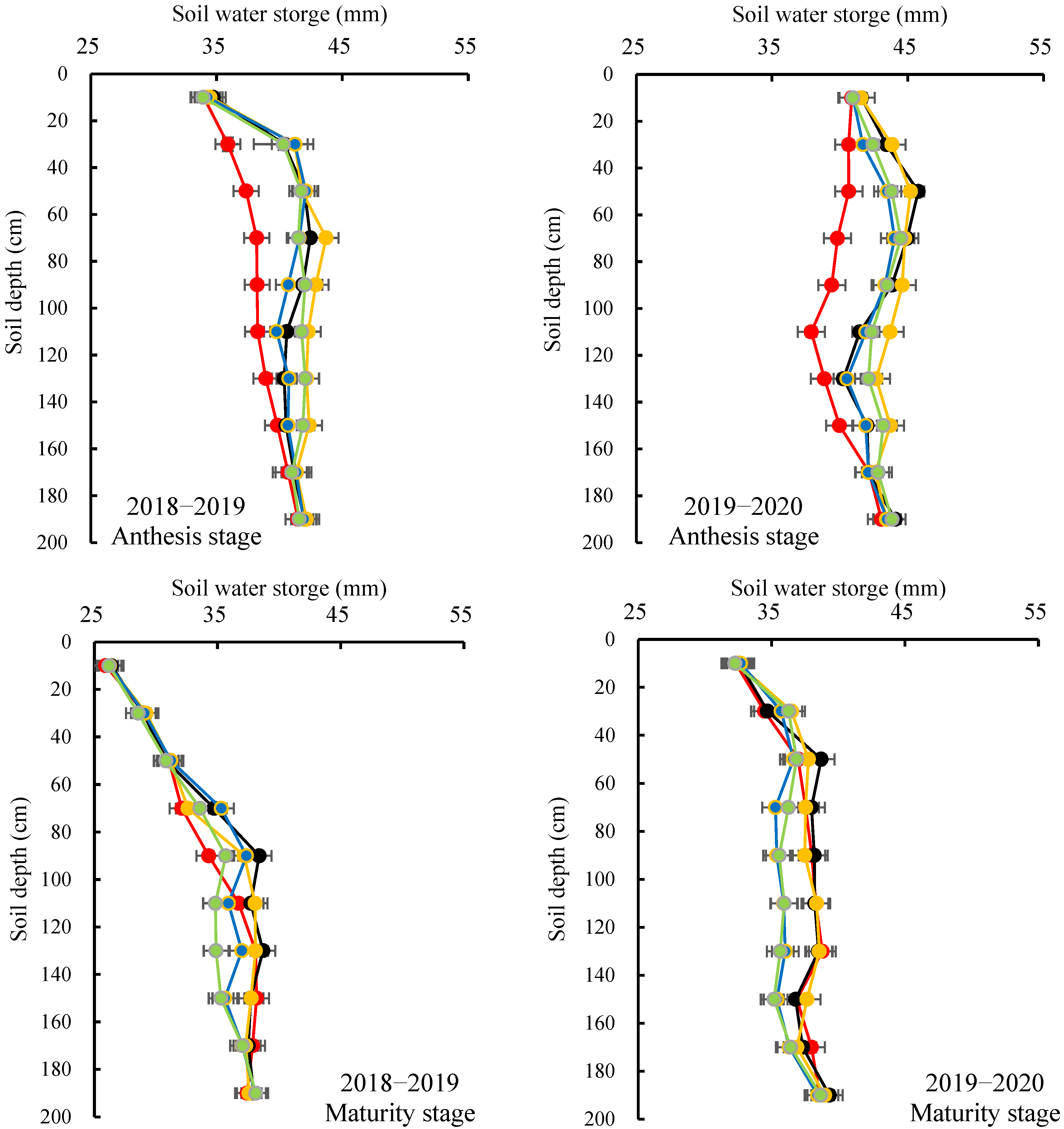
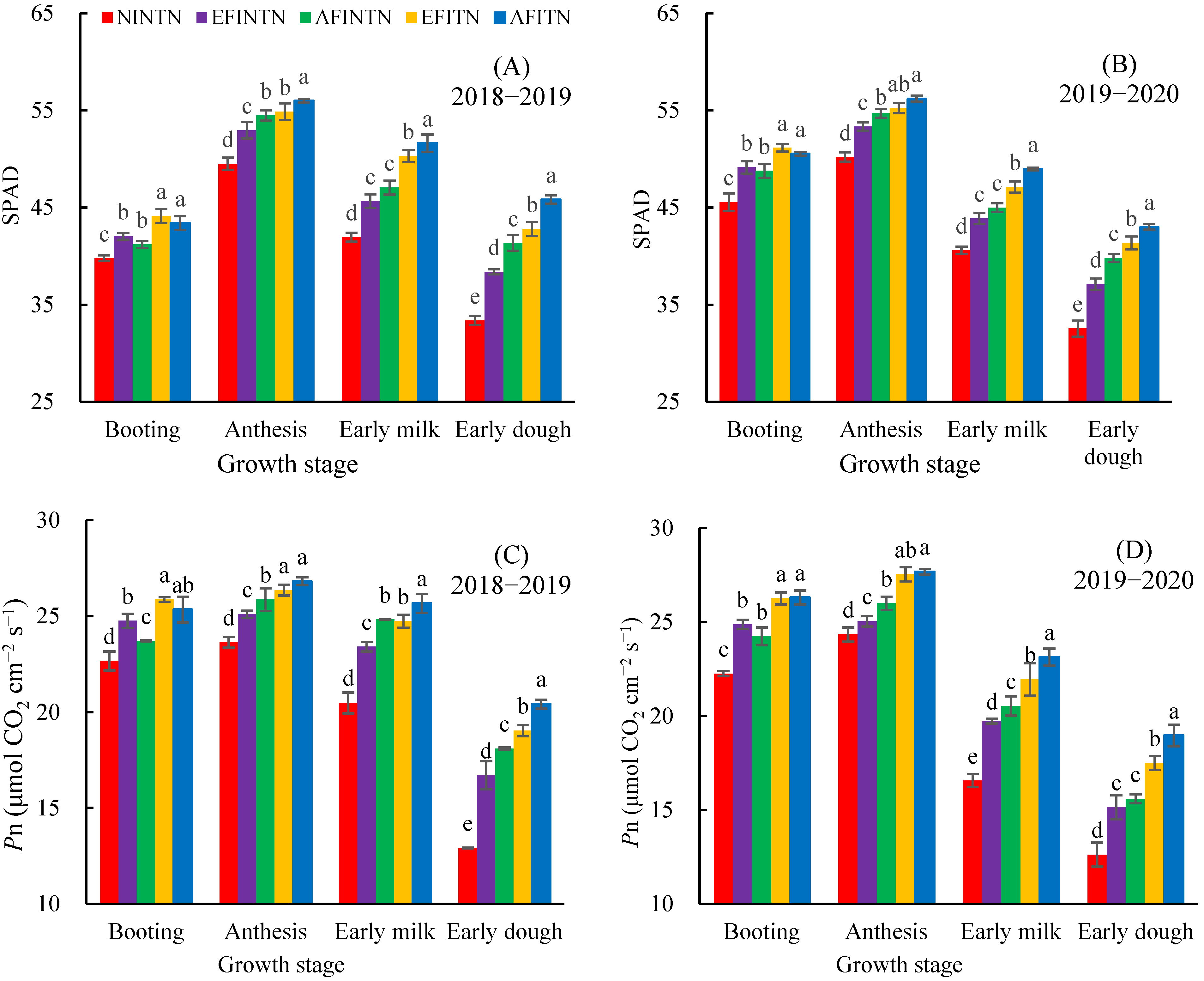
| Year | Soil Depth (cm) | FC (%) | BD (g cm−3) | SOM (g kg−1) | TN (g kg−1) | AP (mg kg−1) | AK (mg kg−1) | pH (H2O) |
|---|---|---|---|---|---|---|---|---|
| 2018–2019 | 0–20 | 27.4 | 1.36 | 13.2 | 0.81 | 13.2 | 125.4 | 8.2 |
| 20–40 | 26.8 | 1.41 | 11.3 | 0.74 | 10.1 | 110.9 | 8.4 | |
| 2019–2020 | 0–20 | 27.3 | 1.35 | 13.1 | 0.81 | 12.1 | 121.6 | 8.2 |
| 20–40 | 25.9 | 1.42 | 11.2 | 0.75 | 10.6 | 113.5 | 8.4 |
| Treatments | Irrigation (mm) | Fertilizer Application Rates (kg ha−1) | |||
|---|---|---|---|---|---|
| Basal N | Basal P2O5 | Basal K2O | Topdressing N | ||
| NINTN (control) | 0 | 172.5 | 75 | 45 | 0 |
| EFINTN | 75 | 172.5 | 75 | 45 | 0 |
| AFINTN | 75 | 172.5 | 75 | 45 | 0 |
| EFITN | 75 | 172.5 | 75 | 45 | 60 |
| AFITN | 75 | 172.5 | 75 | 45 | 60 |
| Index | Level | Calculated Equation |
|---|---|---|
| C0 | − | C0 = grain yield (WUE) under NINTN |
| Cfi | NTN | Cfi = 1/2 grain yield (WUE) under EFINTN + 1/2 grain yield (WUE) under AFINTN − grain yield (WUE) under NINTN |
| EFI | Cfi = grain yield (WUE) under EFINTN − grain yield (WUE) under NINTN | |
| AFI | Cfi = grain yield (WUE) under AFINTN − grain yield (WUE) under NINTN | |
| Cafi | NTN | Cafi = grain yield (WUE) under AFINTN − grain yield (WUE) under EFINTN |
| TN | Cafi = grain yield (WUE) under AFITN − grain yield (WUE) under EFITN | |
| Ctn | EFI | Ctn = grain yield (WUE) under EFITN − grain yield (WUE) under EFINTN |
| AFI | Ctn = grain yield (WUE) under AFITN − grain yield (WUE) under AFINTN | |
| Cat | − | Cat = (1/2 grain yield (WUE) under AFINTN – 1/2 grain yield (WUE) under EFINTN + 1/2 grain yield (WUE) under AFITN − 1/2 grain yield (WUE) under EFITN) − (1/2 grain yield (WUE) under EFITN − 1/2 grain yield (WUE) under EFINTN + 1/2 grain yield (WUE) under AFITN − 1/2 grain yield (WUE) under AFINTN) |
| Treatment | Booting Stage | Anthesis Stage | Maturity Stage | |||
|---|---|---|---|---|---|---|
| 2018–2019 | 2019–2020 | 2018–2019 | 2019–2020 | 2018–2019 | 2019–2020 | |
| NINTN | 412 c | 428 c | 383 c | 403 c | 341 b | 370 a |
| EFINTN | 452 b | 475 b | 406 b | 430 ab | 349 a | 372 a |
| AFINTN | 461 a | 481 a | 414 a | 436 a | 345 ab | 372 a |
| EFITN | 448 b | 476 b | 404 b | 424 b | 343 b | 358 b |
| AFITN | 460 a | 483 a | 408 ab | 430 ab | 335 c | 359 b |
| F-value | ||||||
| Year (Y) | 736.9 ** | 975.2 ** | 2146.7 ** | |||
| Treatment (T) | 380.2 ** | 149.8 ** | 85.7 ** | |||
| Y × T | 4.2 * | 1.6 ns | 10.7 ** | |||
| Year | Treatment | DAA | PRT | POA | DAM | CRPDA |
|---|---|---|---|---|---|---|
| 2018–2019 | NINTN | 8301 c | 2872 a | 1374 d | 9675 e | 32.3 d |
| EFINTN | 9926 a | 2973 a | 2454 c | 12,381 d | 45.2 c | |
| AFINTN | 9640 b | 2128 bc | 3996 b | 13,636 c | 65.3 b | |
| EFITN | 10,095 a | 2335 b | 4133 b | 14,228 b | 63.9 b | |
| AFITN | 9831 ab | 1892 c | 5036 a | 14,867 a | 72.7 a | |
| 2019–2020 | NINTN | 7401 d | 1405 c | 1719 d | 9120 e | 55.2 d |
| EFINTN | 9641 bc | 2517 a | 2107 c | 11,482 d | 45.6 c | |
| AFINTN | 9411 c | 1989 b | 3219 b | 12,630 c | 61.8 b | |
| EFITN | 10,083 a | 2319 a | 3382 b | 13,465 b | 59.3 bc | |
| AFITN | 9761 b | 1868 b | 4207 a | 13,968 a | 69.2 a | |
| F-value | ||||||
| Year (Y) | 227.8 ** | 51.7 ** | 88.1 ** | 282.5 ** | 4.8 * | |
| Treatment (T) | 201.6 ** | 25.4 ** | 480.4 ** | 1315.9 ** | 97.7 ** | |
| Y × T | 7.9 ** | 21.9 ** | 19.4 ** | 2.5 ns | 23.2 ** | |
| Year | Treatment | Efficient Spikes | Grains Per Spike | 1000–Grain Weight | Grain Yield | Harvest Index |
|---|---|---|---|---|---|---|
| 2018–2019 | NINTN | 475.9 d | 28.1 d | 42.6 c | 4853 e | 43.9 c |
| EFINTN | 584.3 bc | 29.4 c | 42.5 c | 6202 d | 43.8 c | |
| AFINTN | 568.8 c | 32.4 b | 44.6 b | 6999 c | 44.9 b | |
| EFITN | 601.4 ab | 32.3 b | 44.7 b | 7392 b | 45.5 a | |
| AFITN | 608.1 a | 33.5 a | 45.7 a | 7918 a | 46.6 a | |
| 2019–2020 | NINTN | 585.4 c | 20.8 e | 34.5 e | 3571 e | 34.2 e |
| EFINTN | 640.9 b | 25.5 d | 37.5 d | 5209 d | 39.7 d | |
| AFINTN | 661.4 ab | 26.8 c | 39.6 c | 5953 c | 41.2 c | |
| EFITN | 658.6 ab | 28.7 b | 40.6 b | 6515 b | 42.3 b | |
| AFITN | 661.5 a | 29.5 a | 41.9 a | 6943 a | 43.5 a | |
| F-value | ||||||
| Year (Y) | 284.2 ** | 2070.8 ** | 2284.4 ** | 625.5 ** | 14.8 ** | |
| Treatment (T) | 75.0 ** | 541.4 ** | 294.5 ** | 759.7 ** | 2.8 ns | |
| Y × T | 6.8 ** | 43.2 ** | 47.3 ** | 3.1 * | 30.4 ** | |
| Treatment | WCba | WCam | ET | WUE | ||||
|---|---|---|---|---|---|---|---|---|
| 2018–2019 | 2019–2020 | 2018–2019 | 2019–2020 | 2018–2019 | 2019–2020 | 2018–2019 | 2019–2020 | |
| NINTN | 28.8 c | 24.9 c | 42.1 e | 33.5 d | 264 d | 366 c | 18.4 e | 9.8 e |
| EFINTN | 45.7 b | 45.5 b | 57.2 d | 57.1 c | 316 c | 423 b | 19.6 d | 12.3 d |
| AFINTN | 47.0 b | 45.3 b | 69.3 b | 63.9 b | 320 bc | 423 b | 21.9 c | 14.1 c |
| EFITN | 43.4 b | 52.5 a | 61.6 c | 65.7 b | 322 b | 438 a | 23.0 b | 14.9 b |
| AFITN | 52.5 a | 53.1 a | 72.7 a | 70.4 a | 330 a | 437 a | 24.0 a | 15.9 a |
| F-value | ||||||||
| Year (Y) | 14.9 ** | 14.2 ** | 35,874.0 ** | 3371.8 ** | ||||
| Treatment (T) | 28.1 ** | 252.2 ** | 2102.2 ** | 269.6 ** | ||||
| Y × T | 3.4 ns | 10.3 ** | 10.3 ** | 2.7 ns | ||||
| Treatment | Economic Benefit (USD ha−1) | Benefit/Input Rate | ||
|---|---|---|---|---|
| 2018–2019 | 2019–2020 | 2018–2019 | 2019–2020 | |
| NINTN | 988 d | 509 e | 1.18 e | 0.61 d |
| EFINTN | 1408 c | 1040 d | 1.53 d | 1.12 c |
| AFINTN | 1729 b | 1343 c | 1.92 b | 1.49 b |
| EFITN | 1799 b | 1477 b | 1.84 c | 1.50 b |
| AFITN | 2018 a | 1660 a | 2.11 a | 1.73 a |
| F-value | ||||
| Year (Y) | 644.1 ** | 645.2 ** | ||
| Treatment (T) | 613.8 ** | 457.4 ** | ||
| Y × T | 2.7 ns | 5.9 * | ||
| Years | Index | C0 | Cfi | Cafi | Ctn | Cat | ||||
|---|---|---|---|---|---|---|---|---|---|---|
| NTN | EFI | AFI | NTN | TN | EFI | AFI | ||||
| 2018–2019 | Yield | 4853 | 1748 | 1349 | 2146 | 797 | 526 | 1190 | 919 | −393 |
| WUE | 18.0 | 2.4 | 1.3 | 3.5 | 2.3 | 1.1 | 3.3 | 2.1 | −1.0 | |
| 2019–2020 | Yield | 3571 | 2010 | 1638 | 2382 | 744 | 428 | 1306 | 990 | −562 |
| WUE | 9.8 | 3.4 | 2.5 | 4.3 | 1.8 | 1.0 | 2.6 | 1.8 | −0.8 | |
Disclaimer/Publisher’s Note: The statements, opinions and data contained in all publications are solely those of the individual author(s) and contributor(s) and not of MDPI and/or the editor(s). MDPI and/or the editor(s) disclaim responsibility for any injury to people or property resulting from any ideas, methods, instructions or products referred to in the content. |
© 2023 by the authors. Licensee MDPI, Basel, Switzerland. This article is an open access article distributed under the terms and conditions of the Creative Commons Attribution (CC BY) license (https://creativecommons.org/licenses/by/4.0/).
Share and Cite
Wu, J.; Guan, H.; Wang, Z.; Li, Y.; Fu, G.; Huang, M.; Li, G. Alternative Furrow Irrigation Combined with Topdressing Nitrogen at Jointing Help Yield Formation and Water Use of Winter Wheat under No-Till Ridge Furrow Planting System in Semi-Humid Drought-Prone Areas of China. Agronomy 2023, 13, 1390. https://doi.org/10.3390/agronomy13051390
Wu J, Guan H, Wang Z, Li Y, Fu G, Huang M, Li G. Alternative Furrow Irrigation Combined with Topdressing Nitrogen at Jointing Help Yield Formation and Water Use of Winter Wheat under No-Till Ridge Furrow Planting System in Semi-Humid Drought-Prone Areas of China. Agronomy. 2023; 13(5):1390. https://doi.org/10.3390/agronomy13051390
Chicago/Turabian StyleWu, Jinzhi, Haoyue Guan, Zhimin Wang, Youjun Li, Guozhan Fu, Ming Huang, and Guoqiang Li. 2023. "Alternative Furrow Irrigation Combined with Topdressing Nitrogen at Jointing Help Yield Formation and Water Use of Winter Wheat under No-Till Ridge Furrow Planting System in Semi-Humid Drought-Prone Areas of China" Agronomy 13, no. 5: 1390. https://doi.org/10.3390/agronomy13051390
APA StyleWu, J., Guan, H., Wang, Z., Li, Y., Fu, G., Huang, M., & Li, G. (2023). Alternative Furrow Irrigation Combined with Topdressing Nitrogen at Jointing Help Yield Formation and Water Use of Winter Wheat under No-Till Ridge Furrow Planting System in Semi-Humid Drought-Prone Areas of China. Agronomy, 13(5), 1390. https://doi.org/10.3390/agronomy13051390








